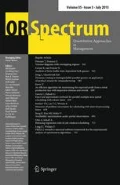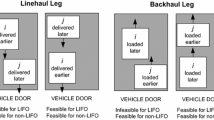Abstract
This paper considers the scheduling problem of multiple vehicles executing a given set of jobs in parallel along a shared pathway. The job set consists of storage and retrieval tasks, transporting goods between a front-end depot and given storage locations on the line. Non-crossing constraints need to be applied to the vehicle movements. This problem setting is relevant when a train is loaded with containers by multiple straddle carriers on the landside of a container terminal. Other potential applications exist in multi-shuttle automated storage and retrieval systems and multi-stage production systems where items are transported by parallel hoists. We formalize the problem, analyze its computational complexity, and develop exact and heuristic solution procedures.







Similar content being viewed by others
References
Boysen N, Emde S, Fliedner M (2013) Scheduling train loading with straddle carriers in container yards. J Oper Res Soc (to appear)
Boysen N, Fliedner M, Kellner M (2010) Determining fixed crane areas in rail-rail transshipment yards. Transp Res Part E Logist Transp Rev 46:1005–1016
Gellert TJ, König FG (2011) 1D vehicle scheduling with conflicts. In: Proceedings of the workshop on algorithm engineering and experiments, ALENEX 2011. Society for Industrial and, Applied Mathematics, pp 107–115
Goldberg DE (1989) Genetic algorithms in search, optimization and machine learning. Addison-Wesley Publishing Company Inc, Reading
Goldberg DE, Deb K (1991) A comparison of selection schemes used in genetic algorithms. In: Rawlins GJE (ed) Foundations of genetic algorithms, pp 69–93
Heinrichs U, Moll C (1997) On the scheduling of one-dimensional transport systems. Technical Report No. 97–277. Center for Parallel Computing, University of Cologne
Holland JH (1975) Adaptation in natural and artificial systems: an introductory analysis with applications to biology, control, and artificial intelligence. University of Michigan Press, Ann Arbor
Hulett H, Will TG, Woeginger GJ (2008) Multigraph realizations of degree sequences: maximization is easy, minimization is hard. Oper Res Lett 36:594–596
Lei L, Wang T-J (1991) The minimum common cycle algorithm for cycle scheduling of two material handling hoists with time window constraints. Manag Sci 37:1629–1639
Leung JMY, Zhang G, Yang X, Mak R, Lam K (2004) Optimal cyclic multi-hoist scheduling: a mixed integer programming approach. Oper Res 52:965–976
Lieberman RW, Turksen IB (1981) Crane scheduling problems. AIIE Trans 13:304–311
Lieberman RW, Turksen IB (1982) Two-operation crane scheduling problems. AIIE Trans 14:147–155
Liu J, Zhou Z (1998) A heuristic method for cyclic scheduling of two hoists without overlapping. In: Proceedings of the 3rd annual international conference of industrial engineering theories, applications and practice, Hong Kong, pp 250.1–250.6
Malmborg CJ (2000) Interleaving models for the analysis of twin shuttle automated storage and retrieval systems. Int J Prod Res 38:4599–4610
Meller RD, Mungwattana A (1997) Multi-shuttle automated storage/retrieval systems. IIE Trans 29: 925–938
Reeves CR (1997) Genetic algorithms for the operations researcher. INFORMS J Comput 9:231–250
Roodbergen KJ, Vis IFA (2009) A survey of literature on automated storage and retrieval systems. Eur J Oper Res 194:343–362
Steenken D, Voß S, Stahlbock R (2004) Container terminal operation and operations research—a classification and literature review. OR Spectr 26:3–49
van den Berg JP, Gademann AJRM (1999) Optimal routing in an automated storage/retrieval system with dedicated storage. IIE Trans 31:407–415
Zhou ZL, Li L (2003) Single hoist cyclic scheduling with multiple tanks: a material handling solution. Comput Oper Res 30:811–819
Acknowledgments
The authors would like to thank the two anonymous referees for their valuable suggestions, which considerably helped to improve the paper.
Author information
Authors and Affiliations
Corresponding author
Appendix
Appendix
1.1 Mixed-integer linear program for VS1D with two vehicles
Given the notation summarized in Table 5, the VS1D with two vehicles can be formulated as a mixed-integer linear program as follows:
subject to
Using objective function (1), the makespan, i.e., the sum of the cycles’ durations, is minimized. Constraint (2) calculates the cycle duration to be either the maximum sum of processing times assigned to both vehicles, or zero if no job is assigned. Note that \(l^{\max }\) is an upper bound on the number of cycles required, which can, for instance, be initialized as \(l^{\max }=|J|\). The non-crossing constraint (3) means that the jobs performed by the inner vehicle are always closer to the depot (i.e., have a lower index number) than the job executed by the outer vehicle in each cycle. Constraints (4) and (5) ensure that a single job, at most, can be processed by the outer vehicle during a single cycle and that each job is processed, respectively. Finally, (6) defines the binary variables.
1.2 Lower bound on the makespan for VS1D
The lower bound on the objective value of the VS1D problem is based on two considerations:
-
First, even if it were possible that all straddle carriers always work in parallel without obstruction, the optimal makespan can obviously never be less than the total workload divided by the number of vehicles; i.e.,
$$\begin{aligned} {\hbox {LB}}_1 = \left\lceil \frac{\sum \nolimits _{j \in J}{p_j}}{m} \right\rceil . \end{aligned}$$ -
Second, if there are \(n\) jobs and \(m\) vehicles, then at least one vehicle must perform at least \(\underline{n} = \left\lceil \frac{n}{m} \right\rceil \) jobs. Let \(\underline{J} \subseteq J\) be the set containing the \(\underline{n}\) jobs with the lowest processing times. The workload of at least one crane cannot be lower than
$$\begin{aligned} {\hbox {LB}}_2 = \sum _{j \in \underline{J}}{p_j}. \end{aligned}$$
We can thus derive the lower bound
Rights and permissions
About this article
Cite this article
Emde, S., Boysen, N. One-dimensional vehicle scheduling with a front-end depot and non-crossing constraints. OR Spectrum 36, 381–400 (2014). https://doi.org/10.1007/s00291-013-0337-4
Published:
Issue Date:
DOI: https://doi.org/10.1007/s00291-013-0337-4




